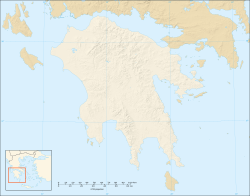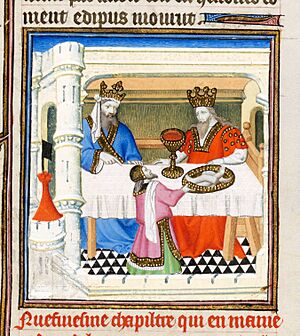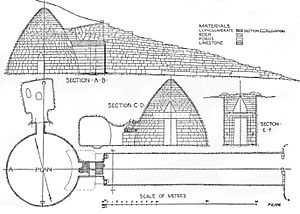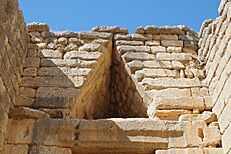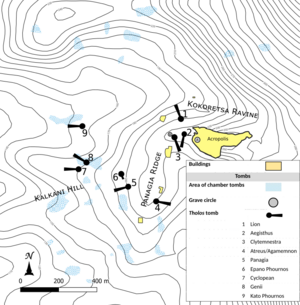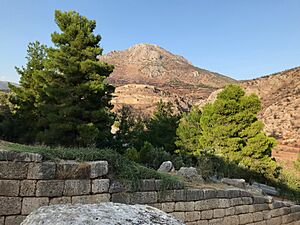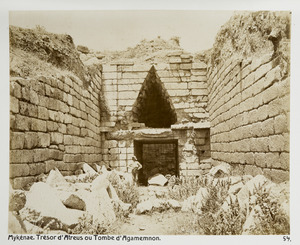Treasury of Atreus facts for kids
|
Τάφος του Αγαμέμνονα
|
|
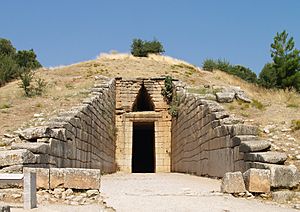
The dromos of the Treasury of Atreus
|
|
| Location | Mycenae, Greece |
|---|---|
| Coordinates | 37°43′37″N 22°45′14″E / 37.72682°N 22.75387°E |
| History | |
| Material | Poros stone, conglomerate, marble. |
| Founded | c. 1400 – c. 1250 BCE |
| Periods | Late Bronze Age |
| Cultures | Mycenaean Greece |
| Site notes | |
| Excavation dates | 1801–1955 |
| Archaeologists | Heinrich Schliemann, Panagiotis Stamatakis, Alan Wace |
| Public access | Yes |
| Designated | 1999 |
| Part of | Archaeological Sites of Mycenae and Tiryns |
| Reference no. | 941 |
The Treasury of Atreus, also called the Tomb of Agamemnon, is a huge ancient tomb. It is a type of tomb called a tholos or beehive tomb. People built it between 1300 and 1250 BCE in Mycenae, Greece.
This tomb is the biggest and most detailed tholos tomb found from the Aegean Bronze Age. It was one of the last ones built in the Argolid region. The main part of the tomb has a round burial room, called a thalamos. A corbelled dome covers this room. This dome was the largest in the world for a very long time, until the Roman period. It is still the world's largest corbelled dome. The front of the tomb was once decorated with marble columns and sculptures. The marble came from the Mani Peninsula in southern Peloponnese. Some think its art was inspired by the Minoan culture from Crete and Ancient Egypt.
We don't know for sure who was buried here. The idea that it belonged to the mythical Atreus and Agamemnon probably started in the 1700s. Building this tomb took a lot of effort. Its design is similar to other buildings in the Mycenae citadel. This makes experts think it was for a ruler of Mycenae. It shows how important Mycenae became in the later Bronze Age.
People first explored the tomb in the 1800s. Parts of its marble decorations were taken by a British aristocrat, Thomas Bruce, 7th Earl of Elgin. The Ottoman governor Veli Pasha also took some pieces. Heinrich Schliemann partly excavated it. Panagiotis Stamatakis did more complete excavations in the 1870s. Later, the British School at Athens did more digs. These were led by Alan Wace and aimed to figure out when the tomb was built.
Contents
What's in a Name?
Myths of Atreus
In Greek mythology, Atreus was the son of Hippodamia and Pelops. Pelops was the king of Pisa. A myth by Hyginus says Atreus and his brother Thyestes killed their half-brother Chrysippus. They threw him into a well because they were jealous. Their mother encouraged them. As punishment, they were sent away to Mycenae.
Atreus and Thyestes fought over the throne of Mycenae. First, Thyestes got it. Atreus' wife, Aerope, gave Thyestes a golden lamb from Atreus' sheep. Thyestes then tricked Atreus into agreeing that whoever had the lamb should be king. Atreus got the throne back later. Hermes convinced Thyestes to give the kingship to Atreus. This would happen if the sun rose in the west and set in the east. Then Helios, the sun god, changed the sun's path to make it happen. Finally, Atreus tricked Thyestes into eating his own sons. After this, Atreus sent Thyestes away.
An oracle told Thyestes to have a son with his daughter, Pelopia. This son was fated to kill Atreus. When the baby, Aegisthus, was born, his mother left him. A shepherd found him and gave him to Atreus to raise. When Aegisthus grew up, Thyestes told him the truth about his parents. Aegisthus then killed Atreus. He ruled Mycenae with Thyestes.
The famous heroes Agamemnon and Menelaus were Atreus' twin sons. They are sometimes called the Atreides. After their father was killed, they went to Tyndareus, king of Sparta. Later, Agamemnon, with Menelaus' help, took over from Aegisthus and Thyestes. He became king of Mycenae. However, Aegisthus and Agamemnon's wife Clytemnestra killed Agamemnon. This happened when he returned from the Trojan War. Agamemnon's son, Orestes, later killed Aegisthus.
Why the Name "Treasury"?
The exact reason for the name "Treasury of Atreus" is not clear. It likely started in the 1700s. The tomb was visible in ancient times. But when Pausanias visited in the 2nd century CE, he didn't connect it to Atreus or Agamemnon. He said their graves were inside the walls of Mycenae.
After Pausanias, no one wrote about visiting Mycenae until 1700. That's when Francesco Vandeyk, a Venetian engineer, saw the tomb. He thought it might be a king's tomb. Later, in 1729–1730, Claude-Louis Fourmont called it the "Tomb of Atreus." By the early 1800s, when Edward Daniel Clarke visited, people knew it as the "Treasury of Atreus." They also linked it to Agamemnon's tomb.
Other nearby tombs, like the Tomb of Clytemnestra and Tomb of Aegisthus, got their names because of their connection to the Treasury of Atreus.
How the Tomb Was Built
The Treasury of Atreus is the largest and most complex Mycenaean tholos tomb. It has three main parts. First, there's a long, narrow path called a dromos. This leads to a deep doorway, or stomion. The doorway opens into the burial room, the thalamos. A corbelled dome covers the thalamos. Earth was piled on top of the dome to make it taller. Some of this earth mound is still there.
The dromos (pathway) runs east to west. It is 36 meters long and 6 meters wide. The first 19 meters from the doorway have walls made of conglomerate stone. Earlier tombs used rough stone for their paths. But the Treasury of Atreus was the first at Mycenae to have full conglomerate walls. This stone likely came from near Mycenae. Experts estimate the stone in the dromos weighs over 1,200 tons. The walls get taller and thicker closer to the tomb's front. This helps them hold up the earth and the tomb's façade. The walls were built with a yellow clay mortar, common in Mycenaean buildings.

The front of the doorway is 10.5 meters high. The doorway itself is 5.4 meters high, 2.7 meters wide, and 5.4 meters deep. Two huge stone blocks sit above the doorway. The inner one is 8 meters long, 5 meters wide, and 1.2 meters thick. It weighs about 120 tons! Moving it might have needed 1,000 people. Above the doorway is a 'relieving triangle'. This space helps take weight off the huge stone blocks below. This was a new idea first used at Mycenae on the Tomb of Aegisthus. This triangle was probably decorated with sculptures.
The tomb's front was once very fancy. It had half-columns made of green marble next to the door. These columns had zig-zag patterns. Two smaller half-columns were on either side of the relieving triangle. Red marble was used for a frieze (a decorative band) with rosettes above the door. Spiral patterns in red marble filled the triangular opening. This red marble, called rosso antico, came from quarries on the Mani peninsula. Some experts think the green marble came from there too.
The thalamos (burial chamber) is made of 33 layers of cut limestone. It is 14.5 meters across and 13.2 meters high. Builders first dug a round hole into the hillside. Then they built the stone dome inside it. Small holes from nails have been found inside. This suggests decorations, maybe gold rosettes, once hung from the dome. A 2.5-meter-high doorway on the north side leads to a 6-meter square side room. The Treasury of Atreus is one of only two Mycenaean tholos tombs known to have a side room. Most experts believe this side room was where burials took place. However, no direct proof of burials has been found.
The earth mound above the tomb was held up by a wall of poros stone. This stone likely came from hills northwest of Mycenae. A flat area, about 27 meters long and wide, was built in front of the tomb.
Building tholos tombs showed great power. The tomb's design is similar to the walls and palace on the Mycenae acropolis. For example, the relieving triangle looks like the sculpted relief on the Lion Gate. Also, a lot of conglomerate stone was used in the tomb. This stone was also used in the citadel to highlight important parts of buildings. Some think the tomb's slanting doorway was inspired by Ancient Egyptian architecture. The spiral patterns might come from Minoan art.
We don't know much about the workers who built the tomb. Some think the same team who built the palace on the acropolis later built the Treasury of Atreus. They might have been forced to work as part of a public service system. Building the tomb needed at least 20,000 days of work. It might have taken up to 1,600 people and lasted for years or even decades.
No one knows for sure who was buried inside. But it is generally believed to have been a very important person, perhaps a ruler of Mycenae.
When Was It Built?

The exact date of the tomb was once a big debate among experts. But most now agree it was built between 1400 and 1250 BCE. In the early 1900s, two archaeologists, Arthur Evans and Alan Wace, had a famous disagreement. Evans believed that Mycenaean civilization on mainland Greece came from Minoan Crete. He thought the tombs at Mycenae, including the Treasury of Atreus, were copies of Cretan structures.
However, Alan Wace and Carl Blegen argued that Mycenaean culture was unique to mainland Greece. They believed it developed there, even with some influence from Crete. Wace suggested a later date for the Treasury of Atreus, around 1400–1200 BCE. This was different from Evans's idea of 1600–1500 BCE. This disagreement was even called the "Helladic Heresy" by some.
Later excavations by Wace in the 1930s helped confirm a later date. He found evidence that the tomb's pathway was dug through soil that contained pottery from around 1400-1300 BCE. This meant the tomb had to be built after that time. Today, most experts agree that the Treasury of Atreus and the main fortifications of Mycenae, like the Lion Gate, were built around the same time. This was during the Late Helladic III period.
The Treasury of Atreus is thought to be the second to last tholos tomb built at Mycenae. The Tomb of Clytemnestra was likely built after it.
Where Is It?
The ancient city of Mycenae is in Argolis, in the northeast Peloponnese. The Treasury of Atreus is west of the modern road to the citadel. It is about 500 meters southwest of the famous Lion Gate.
The earliest tholos tombs at Mycenae were built near the Kalkani necropolis (burial ground). But later tombs, like the Lion and Aegisthus tholoi, were built much closer to the acropolis (the high city). The Tomb of Clytemnestra also followed this trend. This divides Mycenae's nine tholos tombs into two groups. The tombs closer to the citadel are larger and more detailed. This suggests they might have been for more important people, perhaps royalty.
The Treasury of Atreus stands alone on the southern edge of a natural dip. Before it was built, another building was on this spot. Experts think the tomb's location was chosen carefully. It might have been placed to connect with past traditions without directly competing with current burial sites. Its position also allowed for great views of the citadel from the tomb and vice versa. This would have shown the connection between the buried rulers and the living leaders of Mycenae. Some also believe its spot was chosen to make a big impression on people arriving from the south.
The path (dromos) was built in a way that fit the hill's slope. This made it easier to construct.
After Mycenae
A piece of a 7th-century BCE pot was found near the tomb. It had a horse on it. This suggests that people might have visited the tomb for religious reasons later on. Unlike other tombs at Mycenae, there isn't much direct proof of the Treasury of Atreus being used after the Mycenaean period. However, some bronze items found inside might be from a later time, called the Geometric period. In other tombs, later finds are sometimes seen as signs of a Greek hero cult. This means people might have worshipped the heroes believed to be buried there.
Digging Up the Past
In the 1800s, local people believed the tomb had been explored by the agha (a local leader) of Karvati village. He supposedly took a bronze lamp from it. The first recorded entry into the tomb was by the British aristocrat Thomas Bruce, 7th Earl of Elgin, in 1801. He sent people to investigate sites in Greece and find old objects for Britain. His team reported the Treasury of Atreus as a "stupendous" building. They noted it was open to the weather and hard to access due to rain and debris.
Elgin himself visited in 1802. He crawled through the tomb's relieving triangle. He asked the local governor to clear the tomb. When it was cleared, Elgin received pieces of pottery, stone decorations, and a marble vase. He also had parts of the columns from the doorway removed and sent to England. These included fragments of gypsum reliefs showing bulls.
In 1810, Veli Pasha, the Ottoman governor of the Morea, excavated the monument. He cleared most of the entrance and entered the chamber using ladders. According to Heinrich Schliemann, Veli Pasha found "bones covered with gold," as well as gemstones and other gold and silver items. Veli Pasha sold some items to British politicians. He also removed four large pieces of the half-columns from the doorway. One piece ended up in a mosque in Argos. Veli Pasha gave the others to Howe Browne, 2nd Marquess of Sligo. Sligo took them to his estate in Ireland. In 1904, his grandson found them in a basement. He offered them to the British Museum, where they joined the pieces Elgin had taken earlier.
Heinrich Schliemann might have explored the tomb during his quick, unauthorized digs at Mycenae in 1874. In 1876, he dug in the side chamber. He found a small pit whose purpose is still unknown. Later, between 1876 and 1879, Panagiotis Stamatakis cleared the path (dromos) and entrance. He found more pieces of sculpture that likely came from the relieving triangle.
In the 1920s, archaeologists from the British School at Athens, led by Alan Wace, did smaller digs. Their goal was to figure out the tomb's date. Wace also had the first detailed architectural drawings of the tomb made by Piet de Jong.
Another dig happened in 1939. Wace dug trenches outside the path. He found that the front of the tomb and the path were built at the same time. He also found that the path was dug through older soil. This soil contained pottery from around 1400-1300 BCE, which helped date the tomb's construction.
In 1955, Wace dug more test trenches around the tomb. He found many Mycenaean pottery pieces. These are thought to be offerings made to the people buried in the tomb.
Gallery
-
Reconstruction of a capital in the National Archeological Museum, Athens
See also
- List of megalithic sites
- List of world's largest domes


